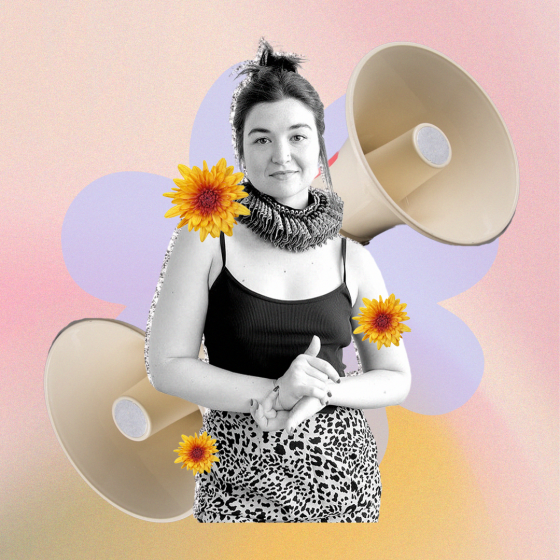Earlier this year I fell over. It was the second time in the space of two months that I’d toppled to the ground like a toddler. I’ve always had a sneaking suspicion that being clumsy is a feminist issue, something that’s bigger than me being prone to tripping. And as I hobbled out of the GP surgery, waiting for family and friends to make their usual jokes about my clumsiness, I decided that there must be more to it. I needed to delve deeper.
I’d always just put up with being unable to judge how much space I took up, accepting it as an annoying-but-adorable character trait, a terminal condition that doesn’t really matter. That is, until now. Now I feel full of rage and questions.
I start to spot the romanticising of female physical ineptitude in Bechdel Test-failing films. I watch friends exercising to punish or shrink themselves, but never to strengthen them for the things they love to do or to improve their coordination. I see a world that regards the female body as for consumption, comment and conquering. I receive the message over and over again in so many ways that my body isn’t really mine to train, protect or enjoy. Thus my apparent clumsiness takes on a more sinister dimension.
I decided to conduct an unscientific survey, asking my Instagram followers about their experiences of clumsiness. Over 400 replied, and I was shocked that 60% of the almost-exclusively female respondents felt that they were accident prone, lacked dexterity or had poor spatial awareness. Nearly 70% said others described them as ‘clumsy’. My inbox was flooded with messages from women telling me how, like me, they were always breaking things, or couldn’t catch, or fell over a lot. A few had conditions like dyspraxia to explain their clumsiness but most did not. And given that this developmental coordination disorder is four times more common in men than women, I began to wonder why it wasn’t my male friends and family who thought of themselves as less physically able.
It’s hard to get to the bottom of why the majority of women I know think they are physically challenged. There’s no agreed normal level of coordination and, as far as I can discover, little research into this specific area. But it’s clear to me that the odds are stacked against women practicing spacial awareness, improving their coordination, dexterity, strength and balance or having confidence in their bodies as useful tools.
As a kid my academic achievements, creativity and good behaviour earned me plenty of praise, but my body was exclusively something that needed to be clean, well-presented and, as I got older, slim. It didn’t need to work properly and maybe it was better if it didn’t. I struggled with sports that required hand-eye coordination and could never do a forward roll. Yet instead of the opportunity to improve these skills and a reminder that they could be learned, my lack of flexibility and inability to hit a ball became a joke; feeling all the more inevitable as it became part of our family’s mythology.
Things were different for my brother. He was encouraged to play sport; his strength, daring deeds and manual labour were facilitated and rewarded. I didn’t do Sunday morning rugby like him, and when I struggled with balancing on a beam, I received the message that this wasn’t something I was likely to improve on. Society reinforced that for me it wasn’t necessary, and for him, it somehow was.
A recent BBC documentary demonstrating the impact gender stereotyping can have on seven-year-olds, found that girls understated their physical abilities. One little girl burst into tears of shock when she won the physical strength test, beating the boys she’d said earlier were stronger and braver than girls. Experiments showed adults offering female babies toys that stimulate caring or creative impulses, whereas male babies had construction toys pushed on them. The documentary made the link that a lack of Lego and construction games in many of the girls’ lives had made them lag behind the boys in spatial awareness.
When researching clumsiness, Charles “Buz” Swanik and a team of academics found that athletes were more likely to be accident-prone if they had poor visual and verbal memory and slow processing speeds. He concluded that a significant part of how clumsy we are is related to how our brains work and that brain training could help clumsy people to overcome their accident prone nature.
I doubt there are many children – of either gender – who formally train their brains to improve their physical capabilities. However, very ordinary childhood activities perform the function of training our brains for the things we ask of them later on. As children we aren’t aware that building cranes with Meccano, climbing trees or using building blocks is training our brains to be more physically competent, research shows that it is. This NHS advice on improving spatial awareness in children prioritises play that includes sports, obstacle courses and construction toys.
I think many women would reflect on their childhoods and spot less opportunity to train their brains through play and sports in the way their brothers and male friends did. Researchers like Becky Francis have pointed to the important role that toys and play has in cornering children into gender roles. Perhaps clumsiness and its association with women is no exception and can be – at least in part – traced back to an overly gendered attitude to play.
Of course clumsiness is more complex than this and every example of women’s clumsiness can’t be laid at the feet of the patriarchy. Sudden-onset or big changes in physical awareness and ability can be signs of serious illness in men and women. For some people a life-long struggle with coordination might be due to dyspraxia. Factors such as insomnia and anxiety (which can leave your thoughts distracted, your palms sweaty) as well as stress and puberty can all have an impact on our clumsiness.
Yet even within these cross-population issues, women can sometimes unwittingly be on the dexterity back foot. I can tie my most extreme accident-prone moments to when I’m overworked, under-slept or distracted. At these times my mind is rarely on the physical task I am doing and – boom – I’m on the floor or bashing myself against a door frame again. We know that women (especially married women with children) are still more likely to be left with the lion’s share of the housework, the emotional labour of parenting and relationship-tending. Women are much more likely to be carers as well as career-people. Women are inherently more distracted, stressed and twice as likely to suffer from an anxiety disorder than men. The reality of women’s lives may mean that we just don’t have the space in our heads to avoid smacking into the doorframe we didn’t learn to avoid when we were little.
For me, I think that my brain was always a bit more adept than my body – though whether that was natural tendency or messages about my gender role and capability I received from birth I’ll never know. Because of that, I was never confident enough or interested enough in my physical abilities to put the energy and time into improving them. Perhaps more importantly, no one encouraged me to and I was never told that it was possible for me to be flexible, nimble and strong. If I had been a boy I feel certain my experience would have been different.
Today, as an adult woman with a multitude of responsibilities, there is enough anxiety, stress and sleeplessness to keep my clumsy tendencies alive and kicking. Except now I am resisting. I am working on my balance and strength, trying to train my brain, manage my stress and change my physical story. Clumsy is an issue that comes out of the gendered paradigm that shape our lives, and so I reject it. I am no longer clumsy, just a work in progress.
Artwork by Esme Rose Marsh









